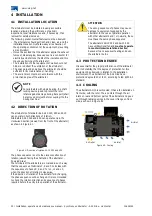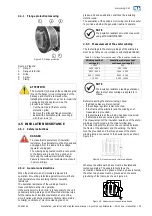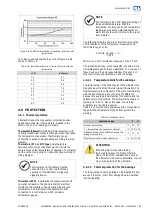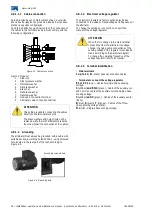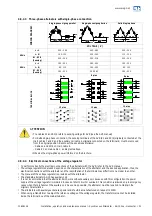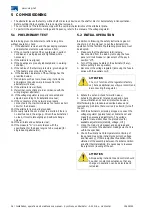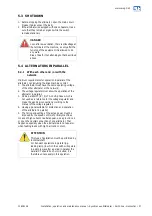
22 l
Installation, operation and maintenance manual – Synchronous Alternator – AG10 line - Horizontal 12638144
4
INSTALLATION
4.1
INSTALLATION LOCATION
The alternator must be installed in easily accessible
locations, allowing the performance of periodic
inspections, local maintenance and, if necessary, their
removal for external services.
The following environmental features must be observed:
The alternators should get fresh and clean air and the
installation location must allow easy air exhaustion of
the operating environment of the equipment, preventing
air recirculation;
It must be avoided that the alternator aspire the exhaust
fumes of diesel engine, because soot is a conductor for
electricity and shortens the life of the insulation and this
may cause burning of the alternator;
The installation of other equipment or walls should not
hinder or obstruct the ventilation of the alternator;
The space around and above the alternator should be
sufficient for its maintenance or handling;
The environment must be in accordance with the
protection degree of the alternator.
NOTE
For alternators with single bearing, the shaft-
locking device (used to protect the rotor
/stator against damage during transport) shall
be removed only just before coupling it to the
driving machine.
4.2
DIRECTION OF ROTATION
The alternators of standard line AG10 250, 280 and 315
can operate in both directions of rotation.
Alternators AG10 355 and 400 can operate only in the
clockwise direction (viewed from the front of the alternator)
as shown in Figure 4.1.
Figure 4.1: Direction of rotation AG10 355 and 400
The phase sequence is set to the
clockwise direction
of
rotation (viewed facing the shaft end of the alternator -
Powered Side).
The terminals of the alternators are marked in such a way
that the sequence of terminals 1, 2 and 3 coincides with
the sequence of phases R, S and T or L1, L2 and L3,
when the direction of rotation is clockwise.
If the direction of rotation of the alternator ford changing,
the phase sequence will be changed. It is recommended
to check the rotation direction and sequence of phases
required before the entry into operation of the alternator.
ATTENTION
The wrong sequence of phases may cause
damage to equipment supplied by the
alternator. In the case of parallel operation
with other alternators and / or network, these
must have the same phase sequence
.
The alternators AG10 355 and AG10 400
have unidirectional fan and
must not operate
in counterclockwise rotation direction
,
because it can cause overheating and even
the alternator burns.
4.3
PROTECTION DEGREE
It is essential for the proper performance of the alternator
and its durability, that the degree of protection for this
equipment be observed in relation to the installation
environment. The alternators of the AG10 line have
protection degree IP23 or IP21, according to IEC 60034-5
standard.
4.4
COOLING
The alternator AG10 is self-cooled. It has a fan installed on
front side, with the rotor. The air enters through the air
inlets on rear and bottom parts of the alternator and goes
out through radial openings in the cover / flange on front
side, as shown in Figure 4.2:
Figure 4.2: Cooling
Air Outlet
Air Inlet
Air Inlet
Air Outlet















